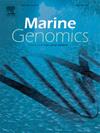Complete genome sequence of Lysinibacillus sp. WB86, a potential antimicrobial lanthipeptides producer
IF 1.5
4区 生物学
Q4 GENETICS & HEREDITY
引用次数: 0
Abstract
Lysinibacillus sp. WB86 was isolated from a cold seep in the South China Sea, and its complete genome was sequenced using Oxford Nanopore Technologies (ONT). The genome consists of a single circular chromosome spanning 4,537,071 bp, with a G + C content of 37 %. FastANI analysis revealed a 99.38 % average nucleotide identity (ANI) with Lysinibacillus sphaericus A1, confirming its classification as a strain of L. sphaericus. Genome annotation identified 4397 protein-coding genes, along with 111 tRNAs and 34 rRNAs. Functional categorization using the COG database assigned 84.6 % of the protein-coding genes to specific roles, with the majority involved in transcription, amino acid transport and metabolism, translation and ribosomal biogenesis, and replication, recombination, and repair. Additionally, antiSMASH-based analysis uncovered eight biosynthetic gene clusters (BGCs), only one of which exhibited high similarity (>50 %) to known BGCs. This cluster was predicted to encode novel antimicrobial lanthipeptides, suggesting potential biotechnological applications.
一种潜在的抗菌镧硫肽产生菌Lysinibacillus sp. WB86的全基因组序列
利用牛津纳米孔技术(Oxford Nanopore Technologies, ONT)对从南海一处冷渗漏中分离到的Lysinibacillus sp. WB86进行了全基因组测序。基因组由一条长4,537,071 bp的单圆形染色体组成,G + C含量为37%。FastANI分析显示,与球形赖氨酸芽孢杆菌A1的平均核苷酸同源性为99.38%,证实其为球形赖氨酸芽孢杆菌。基因组注释鉴定出4397个蛋白质编码基因,以及111个trna和34个rnas。COG数据库的功能分类将84.6%的蛋白质编码基因分配到特定的角色,其中大多数涉及转录,氨基酸运输和代谢,翻译和核糖体生物发生,以及复制,重组和修复。此外,基于anti - smash的分析发现了8个生物合成基因簇(BGCs),其中只有一个与已知BGCs具有高度相似性(> 50%)。该簇被预测为编码新型抗菌蓝硫肽,提示潜在的生物技术应用。
本文章由计算机程序翻译,如有差异,请以英文原文为准。
求助全文
约1分钟内获得全文
求助全文
来源期刊

Marine genomics
生物-遗传学
CiteScore
3.60
自引率
5.30%
发文量
50
审稿时长
29 days
期刊介绍:
The journal publishes papers on all functional and evolutionary aspects of genes, chromatin, chromosomes and (meta)genomes of marine (and freshwater) organisms. It deals with new genome-enabled insights into the broader framework of environmental science. Topics within the scope of this journal include:
• Population genomics and ecology
• Evolutionary and developmental genomics
• Comparative genomics
• Metagenomics
• Environmental genomics
• Systems biology
More specific topics include: geographic and phylogenomic characterization of aquatic organisms, metabolic capacities and pathways of organisms and communities, biogeochemical cycles, genomics and integrative approaches applied to microbial ecology including (meta)transcriptomics and (meta)proteomics, tracking of infectious diseases, environmental stress, global climate change and ecosystem modelling.
 求助内容:
求助内容: 应助结果提醒方式:
应助结果提醒方式:


